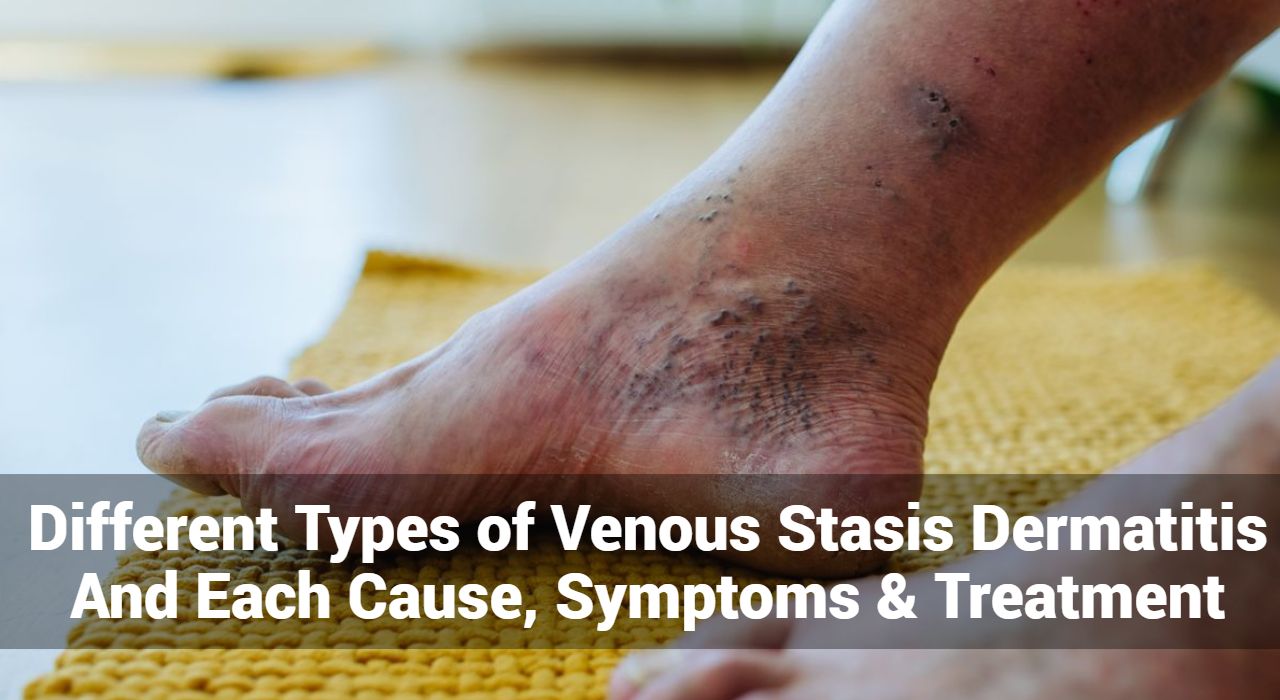Different Types of Venous Stasis Dermatitis And Each Cause, Symptoms & Treatment

Venous stasis dermatitis, a common skin condition, often goes unnoticed despite its significant impact on individuals’ quality of life. In this article, we delve into the intricacies of venous stasis dermatitis, exploring its various types, underlying causes, hallmark symptoms, and effective treatment approaches. Understanding this condition is essential for early detection, proper management, and improved skin health.
What is Venous Stasis Dermatitis?
Venous stasis dermatitis, also known as venous eczema or gravitational eczema, is a common skin condition that occurs due to poor circulation in the veins of the legs. It typically develops in individuals with chronic venous insufficiency, a condition where the veins in the legs fail to efficiently return blood to the heart. As a result, blood pools in the lower legs, leading to increased pressure in the veins and fluid leakage into the surrounding tissues.
Venous stasis dermatitis primarily affects the lower legs and ankles, where symptoms often manifest. The condition is characterized by redness, swelling (edema), itching, and skin changes such as thickened, hardened, or discolored skin. Over time, venous stasis dermatitis can progress to more severe complications, including the development of open sores known as venous ulcers.
Types of Venous Stasis Dermatitis:
Venous stasis dermatitis can manifest in different types, each with its own characteristics and underlying causes. Here are the main types of venous stasis dermatitis:
- Primary Venous Stasis Dermatitis:
- Cause: Primary venous insufficiency due to malfunctioning vein valves, leading to poor circulation and blood pooling in the lower legs.
- Characteristics: Typically develops as a result of intrinsic venous system abnormalities, such as valve incompetence or venous hypertension.
- Symptoms: Redness, swelling (edema), itching, pain, and skin changes such as thickened, discolored, or hardened skin.
- Treatment: Compression therapy (compression stockings), elevation of legs, moisturizers, and lifestyle changes (exercise, weight management).
- Secondary Venous Stasis Dermatitis:
- Cause: Develops secondary to other venous disorders or conditions that impair blood flow, such as deep vein thrombosis (DVT) or venous obstruction.
- Characteristics: Occurs as a consequence of underlying venous pathology rather than intrinsic vein abnormalities.
- Symptoms: Similar to primary venous stasis dermatitis, including redness, swelling, itching, pain, and skin changes.
- Treatment: Addressing underlying venous disorders (anticoagulants for DVT), compression therapy, elevation, moisturizers, and wound care if ulcers develop.
Track and Manage your Eczema treatment using a comprehensive Eczema App
Download Eczemaless now
These types of venous stasis dermatitis share common symptoms and treatment approaches but differ in their underlying causes. Proper diagnosis by a healthcare professional, often a dermatologist or vascular specialist, is essential for determining the type of venous stasis dermatitis and developing an appropriate treatment plan tailored to the individual’s needs. Early intervention and ongoing management can help alleviate symptoms, prevent complications, and improve overall quality of life for individuals with venous stasis dermatitis.
Symptoms of Venous Stasis Dermatitis:
The symptoms of venous stasis dermatitis can vary in severity and presentation but often include:
- Redness (Erythema): The affected skin may appear red or inflamed, especially around the ankles and lower legs. The redness may be diffuse or patchy in appearance.
- Swelling (Edema): Edema, or swelling, occurs due to fluid buildup in the tissues. This swelling is often most prominent around the ankles and may extend up the lower legs.
- Itching (Pruritus): Many individuals with venous stasis dermatitis experience itching or irritation of the affected skin. The itching can range from mild to severe and may worsen with prolonged standing or sitting.
- Pain or Discomfort: Some people with venous stasis dermatitis may experience pain or aching sensations in the legs, particularly after prolonged periods of standing or at the end of the day. This pain may be dull or throbbing in nature.
- Skin Changes: Over time, the skin affected by venous stasis dermatitis may undergo various changes, including:
- Thickening (Lichenification): The skin may become thicker or leathery in texture.
- Hardening (Induration): Hardening of the skin may occur, especially in advanced cases.
- Discoloration: The skin may develop areas of hyperpigmentation (darkening) or hemosiderin staining (brown discoloration) due to the leakage of red blood cells and iron deposits.
- Ulcers: In severe cases, venous stasis dermatitis can lead to the development of open sores known as venous ulcers. These ulcers typically occur on the lower legs, near the ankles, and may be slow to heal.
- Skin Sensitivity: The affected skin may be sensitive to touch and may feel tender or sore, particularly if ulcers are present.
It’s important to note that the symptoms of venous stasis dermatitis can vary from person to person and may depend on factors such as the severity of the condition and the presence of other underlying health issues. Individuals experiencing symptoms of venous stasis dermatitis should seek evaluation by a healthcare professional, such as a dermatologist or vascular specialist, for proper diagnosis and management. Early intervention can help alleviate symptoms, prevent complications, and improve overall quality of life.
GET IN CONTROL OF YOUR ECZEMA
Use our AI tool to check the severity of Eczema and keep track of your Eczema progress.
Treatment Options for Venous Stasis Dermatitis:
Treatment options for venous stasis dermatitis aim to alleviate symptoms, improve circulation, prevent complications, and promote overall skin health. Here are some common treatment approaches:
- Compression Therapy:
- Compression therapy is a cornerstone of treatment for venous stasis dermatitis. It involves wearing compression stockings or wraps to apply external pressure to the legs, which helps improve blood flow, reduce swelling (edema), and prevent fluid buildup in the tissues. Compression garments should be fitted properly and worn consistently as directed by a healthcare professional.
- Elevation of Legs:
- Elevating the legs above the level of the heart whenever possible can help reduce swelling and improve circulation. Individuals with venous stasis dermatitis should aim to elevate their legs several times throughout the day, especially during periods of prolonged sitting or standing.
- Moisturizers:
- Regular use of moisturizing creams or emollients can help hydrate the skin and prevent dryness and cracking, which are common symptoms of venous stasis dermatitis. Moisturizers should be applied liberally to the affected areas after bathing or as needed throughout the day.
- Lifestyle Modifications:
- Lifestyle changes such as maintaining a healthy weight, engaging in regular exercise, avoiding prolonged periods of standing or sitting, and practicing good skin hygiene can help improve circulation and reduce the risk of complications associated with venous stasis dermatitis.
- Wound Care:
- If venous ulcers develop as a complication of venous stasis dermatitis, proper wound care is essential. This may include cleansing the ulcers with mild soap and water, applying medicated dressings or ointments as prescribed by a healthcare professional, and keeping the ulcers covered with a clean bandage to promote healing and prevent infection.
- Medical Interventions:
- In severe cases or when conservative measures are ineffective, medical interventions may be necessary. These may include procedures such as sclerotherapy, vein ablation, or surgical interventions to address underlying venous issues and improve circulation.
- Medications:
- In some cases, medications such as topical corticosteroids or oral antibiotics may be prescribed to reduce inflammation, alleviate itching, or prevent infection, particularly if venous ulcers are present.
It’s essential for individuals with venous stasis dermatitis to work closely with a healthcare professional, such as a dermatologist or vascular specialist, to develop a personalized treatment plan tailored to their specific needs and circumstances. By following recommended treatment strategies and making necessary lifestyle modifications, individuals can effectively manage their symptoms and improve their overall quality of life.
Venous stasis dermatitis is a chronic condition that requires comprehensive management to alleviate symptoms, prevent complications, and improve overall quality of life. By understanding the different types, causes, symptoms, and treatment options, individuals can take proactive steps to manage this condition effectively and maintain healthy skin and legs for years to come. Consulting a healthcare professional, particularly a dermatologist or vascular specialist, is crucial for personalized diagnosis and treatment planning tailored to individual needs.
Track and Manage your Eczema treatment using a comprehensive Eczema App
Download Eczemaless now



